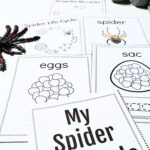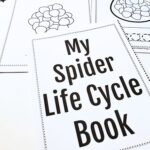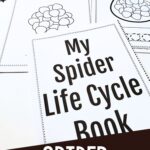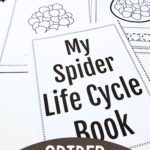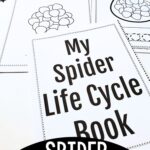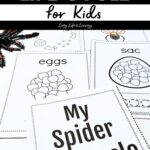Spider Life Cycle for Kids
Creepy arachnids are crawling all over this new printable pack! Get caught up in learning all about spiders and their fascinating life cycle in the Spider Life Cycle for Kids printable book.
See more fun spider activities for kids here.
Spiders aren’t insects, but are their own class of creatures, in the same category as crabs, scorpions, and ticks. They are predators, and many are venomous. And they are incredibly complex, with many different ways of hunting.
Some spiders create the classic web to trap insects. Others will actively hunt their prey, such as the Carolina wolf spider, considered the most aggressive.
Spider silk is considered to be the strongest natural textile in the world. Some spider silks, if human-sized and not spider-sized, would actually be stronger than steel! Scientists are studying spider silk to see if we can duplicate it for things like bike helmets, bulletproof clothing, or bandages.
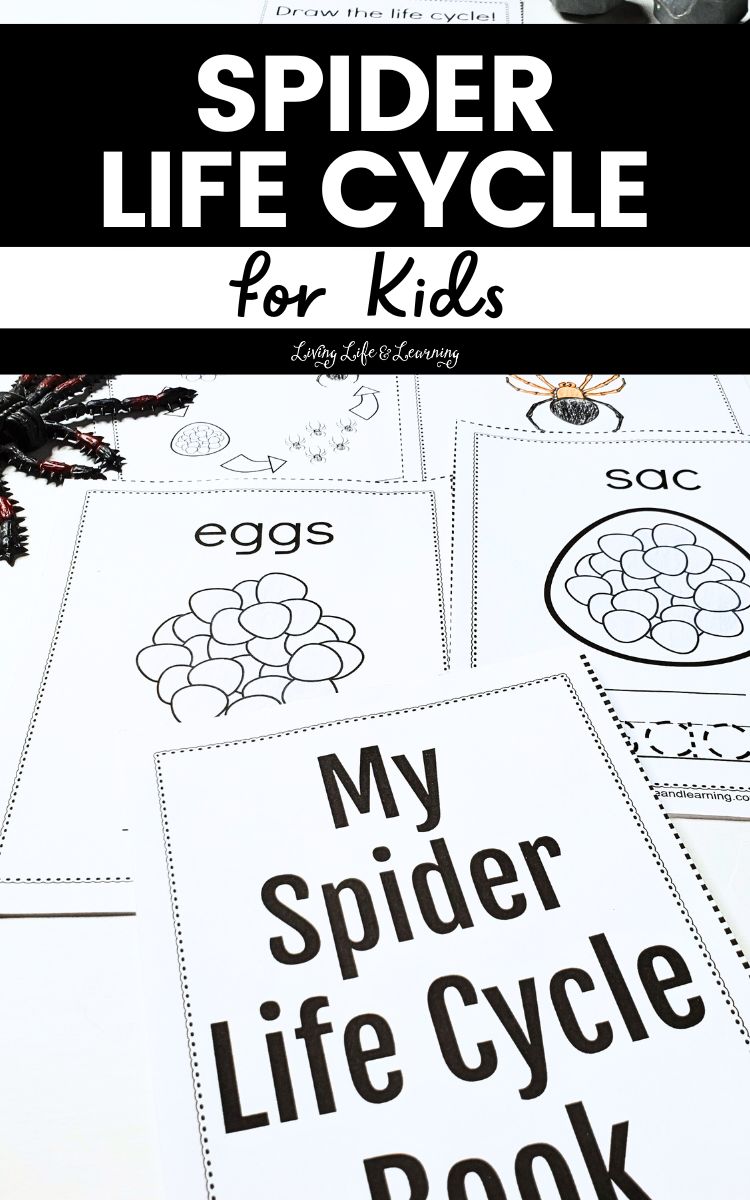
This post may contain affiliate links meaning I get commissions for purchases made through links in this post. Read my disclosure policy here.
Spider Life Cycle for Kids
When it comes to life cycle learning about spiders, these printables are the best! Not only are they a simple way to find out about spiders but they’re great for fall learning as well.
Even if kids are timid or scared around spiders, these worksheets can be a great way to showcase all that they need to learn. Once they see that the life of spiders is unique and interesting, they’re going to want to continue with their learning ways.
I love to use life cycle worksheets in our homeschooling because the kids respond really well to this type of education.
See more life cycle worksheets for kids
Recommended Spider Life Cycle Books
As always, we recommend starting your exploration with a good book. From classic stories such as The Very Busy Spider to the factual photography of The Amazing World of Spiders, you can learn all you want (and more!) about these spooky creatures.
When you want to teach a bit more on a specific topic, books are such a great tool! These allow the kids to come together and learn at their own pace, all with the turn of a page. The more books that you have in the house about a specific topic, the more that the kids are going to want to learn as well.
These are just a few of our favorite books about spiders that I think you’re really going to like and love as well.
Also, check out these Spider Books for Kindergarten and let your kids learn amazing facts about spiders.
The Very Busy SpiderAre You a Spider? (Backyard Books)I’m Trying to Love SpidersNational Geographic Readers: SpidersNational Geographic Kids Creepy Crawly Sticker Activity Book: Over 1,000 Stickers! (NG Sticker Activity Books)Spiders: Amazing Pictures & Fun Facts on Animals in Nature (Our Amazing World Series)
Recommended Spider Printable Activities for Kids
Little Learners Print & Go Activity Kit: Spiders
Spiders are not to be feared, and surely your homeschoolers will learn about that while having an enjoyable time going through this amazing set of spider printable worksheets for kids!
This fun printable bundle is the perfect learning resource added to your homeschool biology curriculum and a great activity for kids who are fascinated with bats and spiders!
Recommended Spider Activity Kits
Learn more about spiders during your homeschool science lessons with these spider activity kit varieties to choose from!
Momoplay Animals Figurine Toys,Animals Life Cycle Set Great for Learning, Cake Toppers, Goodie Bag Fillers (Spider)MOLLYBEE KIDS The Itsy Bitsy Spider Seek and Find Activity PuzzleFLORMOON Realistic Animal Figures – Spider Action Model Lifelike Insect Toy Figures – Educational Learning Toys Birthday Set for Boys Girls Kids Toddlers (Giant Whiteknee)Puzzled 3D Puzzle Black Widow Spider Wood Craft Construction Model Kit, Fun & Educational DIY Wooden ToyBugs, Spiders and Insects!: A Fun Activity Book for Kids and Bug Lovers! (Animal Activity Books)Robo Alive Giant Tarantula by ZURU Battery-Powered Robotic Interactive Electronic Spider That Moves and Crawls, Comes with Web Slime, Prankst Toys for Boys, Kids, Teens
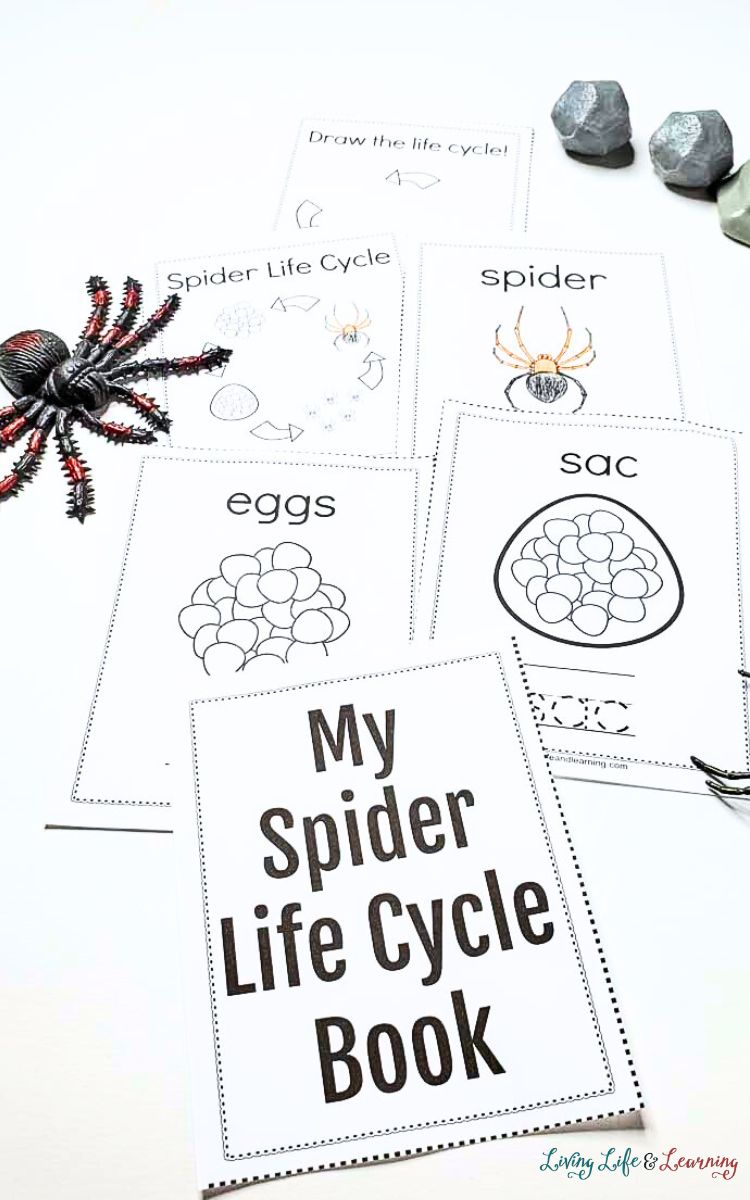
What are the stages of the life cycle of a spider?
Spiders have three stages: egg, baby or “spiderling” and adult. It doesn’t matter what species of spider you talk about — they all go through the same three stages.
Mother spiders die shortly after laying their eggs. Egg sacs can contain anywhere from 4 to 600 eggs, depending on the species. Eggs hatch, and then the little spiders immediately look for food.
Some spiderlings will eat their mothers, while other spider mothers leave their eggs in the web, which will capture prey ready for the babies.
Spiders grow by “molting” or shedding their outer skin. Spiders don’t have skeletons like birds, elephants, or people. Instead, they have exoskeletons or harder outer shells. They are considered “invertebrates”, as they don’t have spines.
So in order to grow, they have to shed their old exoskeleton, when it gets too small. This is called “molting”. They molt between 5-10 times before becoming fully mature.
They will also separate, as most spiders are solitary creatures. There are a few, such as the Ecuadorian spider, that are social and have communal webs, but most spiders live alone.
See more fun life cycle for kids
How long do spiders live?
House spiders typically live about 1 year, assuming people, or curious pets, don’t kill them first. People are generally the biggest threat to most common house spiders. Climate change is the other biggest threat, though spiders do have some natural predators (such as rodents, birds, and other spiders!)
Some species of spiders can live for up to 20 years in captivity. The oldest known spider, a tarantula, died at age 43.
The longest living spider family is the tarantula, living between 15-25 years, depending on which species they are. There are about 850 species of tarantula. And there are over 46,000 different species of spiders!
Did you like this printable spider life cycle book? You’ll love the Little Learners Print & Go Activity Kit: Spiders with more activities for writing, vocabulary, labeling, and more.
What’s Included in the Spider Life Cycle Printables?
Have your kids ever wondered about a spider’s journey from being an egg to the majestic, web-weaving acrobats in your garden? Well, my spider life cycle pages are here to enlighten and entertain their young minds!
Designed with little learners in mind, these spider printables are the perfect way to introduce the wonders of biology in a light, hands-on way. Get ready to trace the steps of a spider’s life with engaging activities that captivate kids’ imagination and nurture their fine motor skills by tracing activities and identifying the correct order of the spider’s life cycle.
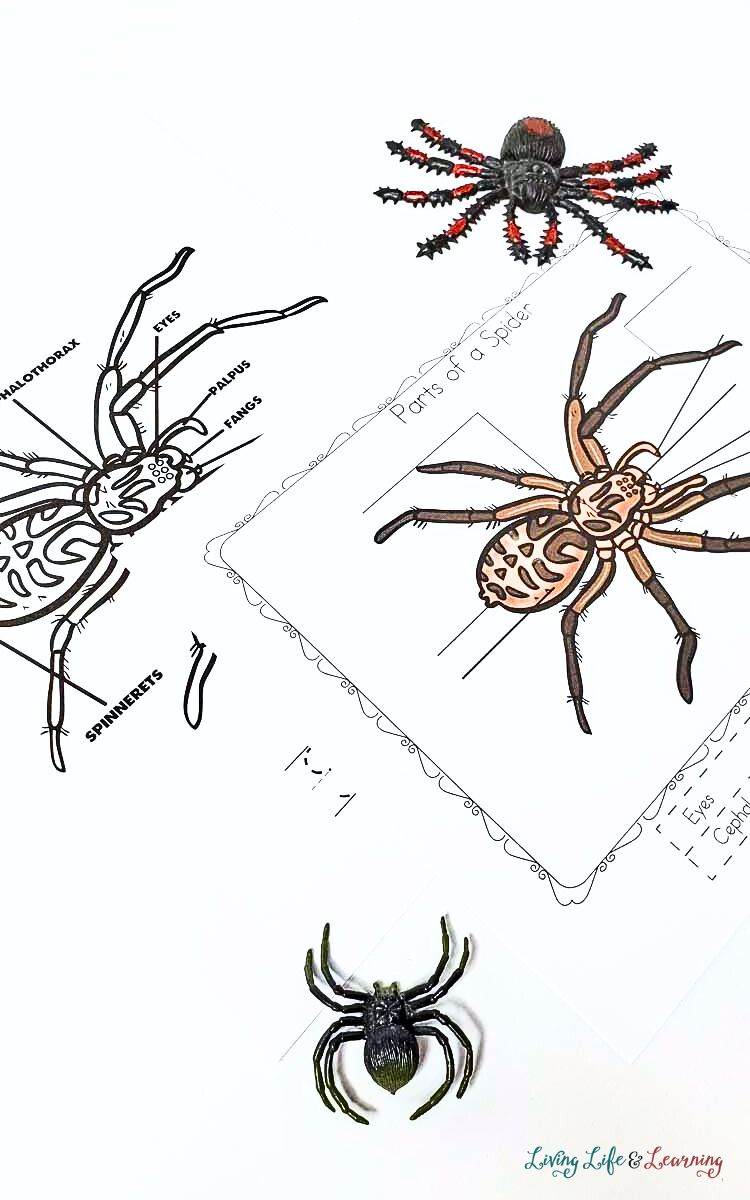
It also includes cards with different types of spiders like the black widow, brown recluse, or Goliath birdeater spider along with more life cycle activities.
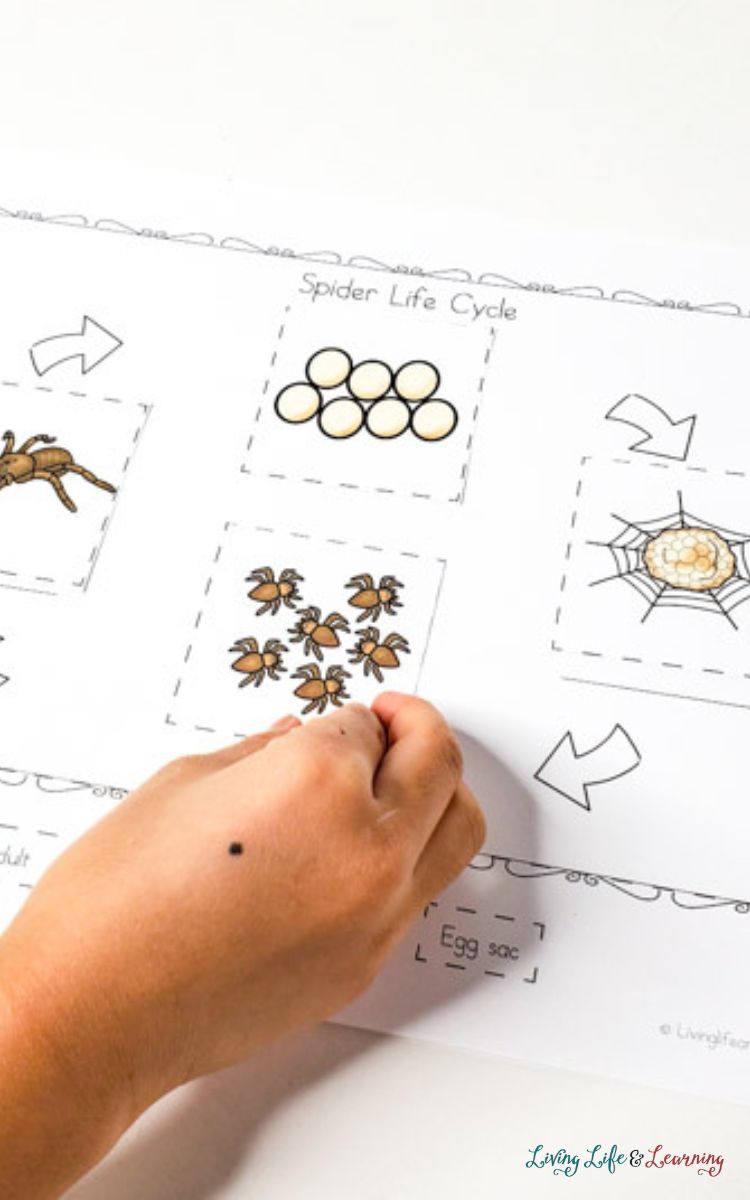
And that’s not all—our printables make learning a breeze by guiding your kids through each stage of a spider’s life cycle. From coloring the tiny spider eggs to identifying the young spiderlings, and to the mature spider, these spider activities are packed with wonderful learning.
Are you ready to learn more about these awesomely creepy arachnids? Download your free printable Spider Life Cycle for Kids book, and build your own web of knowledge.
Download Your Spider Life Cycle Printables Below
Your little ones will become mini scientists and experts on our eight-legged friends, all while enjoying a mix of learning and play!
More Spider Activities
If your kids love learning about spiders, you’re not going to want to miss out on these great spider ideas and activities. There are so many fun spider activities that you can easily learn about and help to teach the kids.
The cool thing about spider facts is that there are so many other fun spiders to learn about in the world! You can challenge the kids to see how many spiders they know and see if they can head out the door and see other spiders as well. They can easily go spider-hunting, too, and see how many they can count in their walk!
Spider Worksheets for Kindergarten
Spider Craft for Preschoolers by Homeschool Preschool
All About Black Widow Spiders by 3 Boys and a Dog
Itsy Bitsy Spider Pack by 3 Dinosaurs

